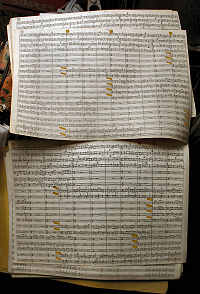A 365-Day Project
"We Are All Mozart"
A project to create
new works and change
the perception of the
music of our time.


 July 18, 2006
July 18, 2006 
For those reading along who aren't composers, it might seem that once a piece is finished and headed for performance that all the troubles are past. Not so. The number of crises in the period from a signed score to an applauding audience seems innumerable. In retrospect, they can be very funny. So it's anecdote day. If you're a composer or performer, you know these kinds of experiences well and can save yourself a few collegial pangs by moving along to The Onion instead.
Not Happenin, Babe
The easy anecdotes are the performances that just don't happen, but the variety of reasons range from the simply confounding to dog-ate-my-homework fantasies.
As a young composer outside of academia (and who for the time had given up the large form, after shelving dozens of pieces including two symphonies, several orchestral tone poems, and a pile of chamber pieces and art songs), I created many street concerts featuring music for mixed amateurs and experienced musicians. One of the few compositions to dip back into a larger ensemble with the Lithuanian Liniment March for band and chorus, written in 1975. It was created for La Vendetta, a piece of absurdist political theatre written by David Gunn and scheduled for presentation during the summer of 1976 at Mill Hill Historic Park in Trenton, New Jersey -- where one of the honored guests at the dedication had come from Lithuania many years before. The play was rehearsed, and the local high school had been preparing the music with their marching band. We were the chorus. All was well until dress rehearsal, when: no band. Nor for the performance. We were stuck onstage singing unaccompanied with an imaginary band. We never heard again from the band director. The march was eventually played, first in a five-hand piano version in 1986 and with full band in 1991.
Fast-forward to the University of Vermont, 1989. The occasion is an "environmental awareness concert." Uh-oh, twigs and rocks. But it was an open call for scores, and I created a piece for a pair of singers, violin, rocks, drums and bass. Not bad so far, but the words didn't quite ring true for the purpose of the concert, or so thought the concert's organizers:
|
Wolves & whales & puppy dog tails, |
Okay, so maybe it wasn't really their fault that Bang the Rocks Together didn't get played that afternoon. Onward...
In 1991, sculptor Fernanda D'Agostino and I received a grant to create an outdoor version of In Bocca al Lupo, our Montana installation. Entitled Traveler's Rest, it included several buildings and a wind-powered acoustic soundscape entitled Wolf5, and was installed a few hundred yards off the interstate exit in Randolph, Vermont. It was a tough build, and the electronics were particularly difficult. The windmill generator charged telephone batteries which in turn powered the computer controls, playback devices, sampling memories, and amplifiers. Time was tight and the soundscape was only running intermittently for the opening reception. At evening's end, when everyone had left the reception, the soundscape finally turned on and worked. Random time-delayed speech sounds came out of building corners and the ground, and the mysterious sounds & music swept across the site. When I arrived a few days later to complete the work, the installation had been vandalized. Sculptures had been stolen and the sound equipment was gone. The debilitated outdoor sculptures stood for the next few months, but they were silenced.
A month after Wolf5, we had missed connections with Clarence Barlow on our arrival in Europe. A night in the drunk-and-druggies hostel had us discouraged, and a day of walking in the rain through unknown streets eventually to the dock to find the houseboat of our backup host Calliope Tsoupaki was getting us nowhere. No one was home. As we dragged away our suitcases through the fall rain, about to take advantage of our open-ended air tickets after just two days, a small car came our way with a smiling, curly haired man at the wheel. He rolled down his window and asked, "Are you Dennis?" It was Pieter Smithuysen, who had been alerted to our possible arrival. We dried off at the houseboat, and soon were enjoying a gathering with Pieter, Clarence, Calliope and composers Martijn Padding and Louis Andriessen. Pieter had been wanting a viola-contrabass duet -- he plays contrabass -- and as as a gift for Pieter on our departure the next summer, I composed Binky Plays Marbles: A Bruckner Boulevard Dance. Unfortunately, it was stylistically disturbing, carrying an all-too-American stamp that did not appeal to him at all; Ferneyhough was his man. We never heard from Pieter again after returning to America, and Binky remains unplayed.
Similar no-go performances happened with Hoots & Honks (the string quartet -- shall I name names? Yes. The Crossroads String Quartet apparently didn't like it and vanished from sight), Warebrook (the Warebrook Festival choral director thought the Biblical words from Nahum 3:1-5, 7, 11, 15, 18, and 19 were too violent), Quince & Fog Falls (Essential Music ignored it and me and never paid or played), VoxN (the Vermont Contemporary Music Ensemble's replacement violinist decided it wasn't worth the effort), Phylum Euphoria (Jiri van der Kaay, after much enthusiasm, stopped returning messages without explanation), and Pianaroll (pianist Sara Krohn thought it would hurt her hands).
Oh, yes. There are so many more, so many more... but other stories are more entertaining.
Near Misses
The number of near calamities is ginormous. Here are just a few.
- The lead soprano begged out of the Ash Wednesday premiere just days in advance. Fortunately, during the PeoplExpress era, an old friend was able to make the trip from New Jersey to Vermont to learn the music with 48 hours' notice.
- An argument between this composer and the director during Beepers almost led to the abandonment of the cabaret a few days before its opening. Some very tense mediation kept the opening on schedule, but attention to the keyboard part was, um, weakened.
- During the preparations for Circular Screaming (of which Xirx was a part), the performance space could not be touched, because play rehearsals were in progress. When the quarter-ton of ice blocks arrived (more here), the producer nearly shut down our show. The negotiation of drip pans saved it.
- There's nothing like a barline. Into the Morning Rain was to be played by the Vermont Contemporary Music Ensemble. Unfortunately, the unbarred bass clarinet lines were creating a rehearsal train wreck. The preparation of a new score and parts with barlines and cues brought the performance to fruition.
- To save the day for Mountain Dawn Fanfare, it was essential not only to help at the podium but also write a new instrumental part to support the tentative horns and to rehearse the newly created section minutes before the performance.
There were rewrite consultations for Northsea Balletic Spicebush and a rewrite of Icecut. In Belgium, L'Estampie du Chevalier almost completely crashed and burned during its first performance. Roundelay -- already delayed 22 years from composition to premiere -- completely collapsed, even though the players soldiered on until the end, an exercise in inadvertent aleatory. Dozens and dozens of other compositions suffered performance injuries and near death (and some deserved it).
The ultimate story has already been told here, but in retrospect it's so astounding that I'll repeat it. ÿçuré, a fanfare-as-isorhythmic-motet was commissioned for the 25th anniversary of the Friends of Music at Guilford in southern Vermont. The orchestra received it with complete hostility. Stevie and I had been hiking in the Grand Canyon for a week, driving back to Vermont in time for the dress rehearsal. The orchestra -- mostly volunteer professionals -- had a new conductor, and the rehearsals were out of hand already as the musicians put her to the test as a new, young, female conductor coming from the choral realm to the orchestral scene. ÿçuré demanded musical coordination and cooperation, as it had changing tempi that were metrically linked, difficult parts, and split the orchestra into two facing chamber ensembles. Upon arriving in Guilford, we noticed a kind of chill. No provisions had been made for us. We slept the night outdoors in our camping tent. The dress rehearsal was tense and the conductor avoided me. I learned that the previous week's rehearsal had gone badly, with performers walking out after a food fight of balled-up ÿçuré parts. By performance day it was little better -- and I still didn't know why. Attempts at socializing failed. When we sat down at one of the communal tables at lunch, the musicians stood up en masse and moved elsewhere. When the orchestra had to be reset for the double ensemble, the players stood in place as if I didn't exist so that I needed to jostle chairs around their bodies (no, a stage hand was conspicuously not provided). As the performance began, the first violinist laughed aloud. A few measures later the oboe put down her instrument for most of the piece. At the conclusion, there was a stunned silence -- followed by an embarrassing (to the musicians) standing ovation. We returned home quickly, where I brooded for weeks. It had become my one crushing scandale.
Delayed Gratification
Sometimes nothing goes wrong, save for the years between composition and premiere. Indeed, had I been Mozart, I would have been dead before some were heard.
I've mentioned the sixteen-year delay until the performance of The Lithuanian Liniment March. The 1969 Composition for Tape & Soloists also rested on the shelf for sixteen years before it was heard in the real air. The large wind ensemble composition Exequy, written on the day of Stravinsky's death in 1971, was first heard twenty years later. The aforementioned massacre of Roundelay waited twenty-two years for its Little Big Horn.
And (so far), the longest wait from composition to performance was for Construction "on nix rest... in china" for two trombones and tape, discovered and premiered in 2003 by Jim Fulkerson and Hillary Jeffrey thirty-one years after its completion.
I'm wrung out writing all these, funny as they seem after time to settle. But if you're considering becoming a composer, be prepared. You can't put your pieces up on easels in the driveway, and electronic demos are pretty cold. You may just have to wait. And wait. And wait.

David Gunn's La Vendetta in the ampitheatre at Mill Hill Historic Park, Trenton, New Jersey in 1976. The high school marching band that was to play The Lithuanian Liniment March is conspicuously absent. (From left: David Gunn, Linda Kay, Richard Fredette, me)